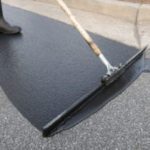Asphalt Sealcoating Layers: Asphalt is one of the most popular choices for homeowners and businesses installing a new driveway or parking lot due to its reasonably low cost, long lifespan, and attractive appearance. Another advantage of this petroleum-like material is that it demands very little maintenance and care. Aside from cleaning away dirt and debris on a regular basis, the only actual maintenance task required for asphalt pavement is sealcoating.
 You have probably heard about the benefits of sealcoating if you own a property with an asphalt driveway or parking lot. Keeping up with this type of preventative maintenance can help you extend the life of your asphalt pavement while also keeping the surface looking incredibly appealing and vibrant in color for a long time.
You have probably heard about the benefits of sealcoating if you own a property with an asphalt driveway or parking lot. Keeping up with this type of preventative maintenance can help you extend the life of your asphalt pavement while also keeping the surface looking incredibly appealing and vibrant in color for a long time.
Most folks will hire professional asphalt contractors to sealcoat their driveway or parking lot instead of taking it on as a DIY project. One of the most common requests from people unfamiliar with the process is for the contractor to apply thick sealant layers. However, any reputable asphalt contractor will probably refuse to do the job this way — and for good reasons. If you want the highest-quality sealcoating results that will last, it is a good idea to apply the sealant in two or more thin layers rather than a single thick layer. Continue reading to find out why.
Why Do Thin Layers Work Better? in sealcoating
 To understand why it is crucial not to glob on the sealant too thickly during the process, you should have a fundamental understanding of how sealants work.
To understand why it is crucial not to glob on the sealant too thickly during the process, you should have a fundamental understanding of how sealants work.
During the sealcoating process, the sealant cures to form a hard shell that protects the surface of your asphalt pavement from elements such as water, oils, and ultraviolet rays. However, for the sealant to cure and form that hard shell, any moisture in the sealant must be evaporated. Unfortunately, moisture will not evaporate evenly or adequately if the sealant layer is too thick.
If it takes too long for the sealant to dry, it will cure unevenly. This means that as soon as vehicular activity begins on top of the sealant, it will deteriorate, crack, or flake as it will not properly bond with the asphalt pavement. As a result, your pavement will not be protected by the sealant — and you will have essentially wasted your money on a subpar sealcoating job.
 The sealant must be applied in such a way that a hard shell forms on the asphalt surface. This shell will shield the asphalt pavement from gas and oil stains, as well as various chemicals that may wind up on top of it or be sprayed on it, such as de-icing agents and spreadable additives. It will also help prevent the surface from tire scuffing and power steering marks. The sealcoating process is virtually pointless without the formation of this hard shell.
The sealant must be applied in such a way that a hard shell forms on the asphalt surface. This shell will shield the asphalt pavement from gas and oil stains, as well as various chemicals that may wind up on top of it or be sprayed on it, such as de-icing agents and spreadable additives. It will also help prevent the surface from tire scuffing and power steering marks. The sealcoating process is virtually pointless without the formation of this hard shell.
If you are sealcoating your asphalt pavement on your own, following the manufacturer’s directions is important. However, we recommend that you work with a professional asphalt contractor for the best sealcoating results.
Address
Commonwealth Paving, 136 Outerloop, Louisville, Kentucky 40214
Phone: 502-459-7283, Fax: 502-456-2678
Opening Hours
| Monday | 9:00 AM – 5:00 PM |
| Tuesday | 9:00 AM – 5:00 PM |
| Wednesday | 9:00 AM – 5:00 PM |
| Thursday | 9:00 AM – 5:00 PM |
| Friday | 9:00 AM – 5:00 PM |
| Saturday | Closed |
| Sunday | Closed |







